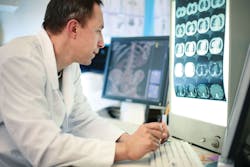For years, the potential of artificial intelligence (AI) and machine learning has been extolled in the specialty of radiology, but early attempts to incorporate AI and machine learning have not always panned out. Now, however, things are moving forward with alacrity.
And one of the most exciting initiatives is being sponsored by leaders at the American College of Radiology (ACR), with participation by radiologists from across the U.S.
That initiative is called the American College of Radiology Data Science Institute ACR AI-LAB, and described, upon its April 5 public launch, as “a free software platform that will empower local radiologists to participate in the creation, validation and use of healthcare artificial intelligence.”
A June update noted that “Radiology professionals from seven renowned healthcare institutions will use the ACR AI-LAB to demonstrate the process of creating investigational artificial intelligence models from image data without the use of a programming language. Using an AI model developed at one institution, each of the seven institutions will have the ability to evaluate and optimize the model for their own investigational use. Based on the recently announced ACR AI-LAB reference architecture,” the ACR stated, “this pilot represents a major milestone in the effort to allow institutions to develop high-quality algorithms that address local clinical needs, some of which may ultimately be made commercially available. In addition to the seven institutions, there are two major technology contributors; NVIDIA is providing software and edge infrastructure, and Nuance is providing last-mile integration to the participating radiologist.”
As the specialty society’s website explained it, “The pilot—originally including Massachusetts General Hospital and The Ohio State University—now also includes Lahey Hospital and Medical Center, Emory University, The University of Washington, the University of California San Francisco and Brigham and Women’s Hospital. NVIDIA will provide its NVIDIA Clara AI software toolkits at no cost to the institutions to perform the annotation creation, transfer learning, and pipeline integration. In addition, Nuance will provide the last-mile technology required to integrate AI for the participating radiologist. Once the pilot is complete, the initiative is anticipated to progressively expand to all institutions interested in participating. Sharing local AI models from image data between institutions for fine tuning—while patient information remains securely on site at the originating institution—has not previously been done successfully in radiology at this scale. This is due, in part, to the variability in how medical images are created, including the equipment, software, and protocols used. The pilot sites will use ACR AI-LAB to evaluate AI developed elsewhere, modifying the investigational algorithms to improve performance based on testing and evaluating them on local patient data. Creating the local AI models will not require ACR AI-LAB users to have programming skills. ACR AI-LAB allows users to adjust and change AI models without having to make line-by-line changes to the underlying code. Once the pilot is complete, the consortium is anticipated to progressively expand to more institutions and vendors interested in participating.”
One of the participating leaders in the initiative, Keith Dreyer, D.O, is the chief data science officer at the Boston-based Partners HealthCare health system, and is vice-chair of radiology at Massachusetts General Hospital and Brigham & Women’s Hospital, two Partners hospitals located in Boston. Dreyer says that “This is the wave of the future. We’re using this network to share information and insights. The problem in taking so long to build these models—there have been missteps. And then small companies that have no access to data grab general data and build a model. So at Partners, Mass General and Brigham, we have 20 billion images, increasing by 1 billion a year, so we can build these models to improve patient care. That’s what’s new and transformational” about this initiative, he said. “These tools are on the verge of being in the hands of radiologists and clinicians. They understand what’s needed and the data, and the environments involved; they just need the models.”
Dreyer also spoke with Hagland more broadly about the overall trajectory of AI in radiology. Below are excerpts from their recent interview.
How do you see the overall trajectory of the adoption of AI and machine learning in radiology practice?
I think you’ll see adoption happening on a regular basis. There will be transformational things happening continuously. At some point in the next five years, people will be using it more than in the past five years. And reimbursement needs to happen; no one gets paid to use AI.
When will the average radiologist be using algorithms to support the bulk of their work?
It’s going to be a gradual thing. Here’s how I think of this: you use the Internet today, and you didn’t use it when you were five years old, right? But I used email in 1988 in my hospital. And I was already banking online by that time. It’s the same kind of thing here—we will see gradual, continuously growing adoption. And people are going to look back and say, it’s crazy it was called AI. The classic question I get from reporters is, what is the amazing thing that’s going to happen with AI? And it’s not going to work like that. It will just be adopted more and more, and become a part of clinical practice.
Will it change things in the non-diagnostic area?
Yes, people are starting to realize there’s incredible value in the data, so there will need to be heightened security and control of data. The classic large companies are trying to find ways to get health records, because that’s how you develop AI. That’s what IBM tried in acquiring Merge, but you need much more structured data. And what it reveals is that we don’t put a lot of that structured data into our interpretations. So one will be data privacy and security, because companies will try to reach into hospitals and steal their data. And two, the quality of the data will improve. We’re doing a project at Mass General and Brigham around interpretations, instead of just saying ‘pulmonary embolism,’ on the image, we’re circling the lesion, and when we circle it, we say what it is to define characteristics, and then we’re putting that into the database.
I thought that was what had happened previously?
What happened was that they ended up with 24 years worth of data, with disparity of different image modalities, devices, and reporting styles, and that it made it harder. It takes a lot more data to get the answers, and how the data is organized makes a huge difference.
What would you like CMIOs, CIOs, imaging informatics leaders, and other healthcare IT leaders to know about all of this?
First of all, absolutely do not release your data to vendors, companies, modality companies, anyone who in theory can see your data, for purposes of giving you an answer for something. For all the companies in our institution that have data access agreements, we have strong language forbidding them from using our data for any reasons. Informatics people become stewards of patients’ data. It’s always been the case, but now it’s more important than ever. Data now has value, so people will be coming out of the woodwork to grab your data.
Might some people become confused about these issues?
Of course they might; this is very confusing. It’s like people going around to old folks who have coin collections and saying, hey, why don’t I take those coins off your hands?
Who will convene everyone, in terms of gathering together the practicing radiologists, the clinical informaticists, and others, to help move the specialty forward?
The ability to make AI, in the future, will be as ubiquitous as creating PowerPoints. As automation starts to happen, more and more people will be able to use this. That’s why the ACR created the Data Science Institute. At its core, its purpose is to teach radiologists what AI is and what it’s not. And just four months ago, we introduced the AI Lab. In terms of building models, you could actually go onto the ACR’s website and do it. You could take data and annotate it, push a button, and create models. Anyone can do it. And that’s the entire point.


